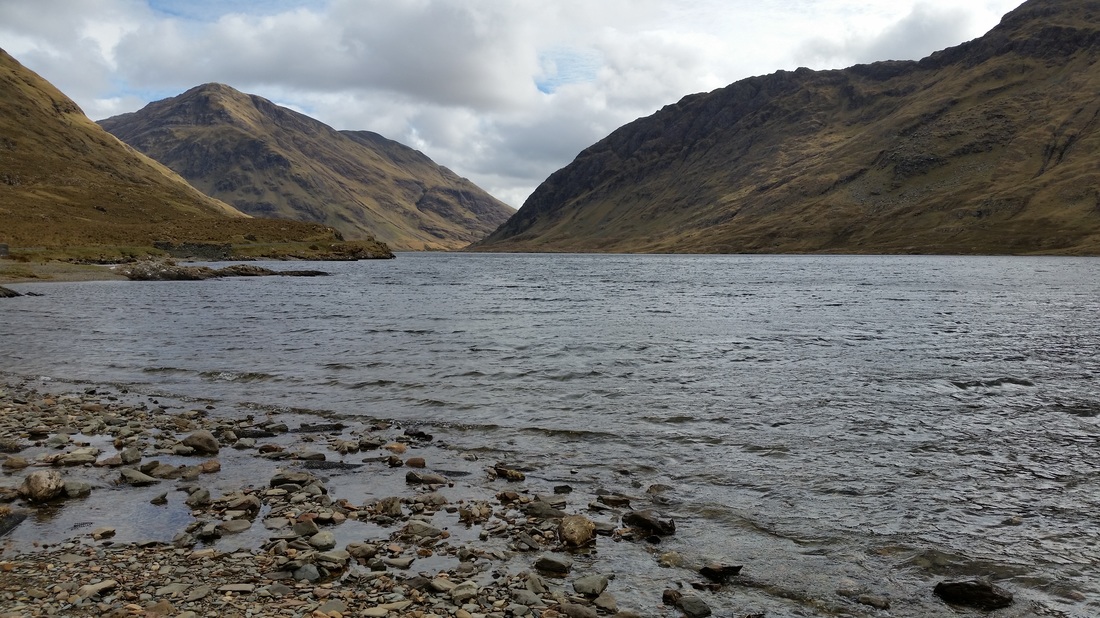Doo Lough itself, by contrast, was lovely, a clear, cold glacial lake nesting between the mountains. [Lough, roughly pronounced as ‘lock,’ is the Irish word for ‘lake.’]
And when I emerged past the southern end of the lake, a sign at the Delphi Lodge announced, innocently enough, “Fresh salmon for sale.”
Which was somewhat ironic, given that the Delphi Lodge and Doo Lough Pass were the setting of one of the most horrific incidents of the Irish Famine.
Nineteenth-century Irish rural life was precarious even before the Famine. Absentee British landlords exacted a “pig for the rent” from Irish tenants who tended the landowners’ cattle and sheep. In return, Irish families coaxed potatoes from small plots for their own subsistence. The potato was the staple diet for 90% of rural Irish tenant farmers.
The land required coaxing. Naturally bogland, certain fields could be converted to small-scale farmland by digging deep drainage furrows and applying a fertilizing mixture of lime, seaweed, and manure to the raised soil mounds between the furrows. Called lazy beds, these potato fields required back-breaking care.
In 1845, a potato blight swept quickly through the Irish countryside, turning potatoes to mush in the fields overnight. It was followed by another blight in 1846, and several more through 1851.
A million people in Ireland died of starvation and another million emigrated. Western Ireland—the province of Connacht—was hardest hit with a 28% population loss during the Famine years.
(Heavy emigration continued through the following decades until the population of pre-Famine Ireland was nearly halved. Most of the potato beds since then have reverted to bog. You can tell which fields once nursed potatoes, though, where faint outlines of the lazy beds still run through the bog.)
In March 1849, a crowd of 600 starving men, women, and children descended upon the new relief station at the town of Louisburgh, hoping for food or admission to the Westport Workhouse. The officer in command said he could provide neither, and instructed them to walk instead the 11 miles through the Doo Lough Pass to the Delphi Lodge in hopes of relief.
As the time was late, the crowd slept on the streets of Louisburgh, and when a wintry night set in, 200 were dead by morning. The rest began their walk to the Delphi Lodge. No road existed yet, just sheep paths through the bog.
When they arrived at Delphi the next day, the relief officers couldn’t be bothered from their lunch, and the crowd was told to wait. Lunch completed, the officers then told them that no food was available, and they should return to Louisburgh. Desperate, some turned to eating grasses from the bog, and died because human stomachs can’t eat what sheep do.
The weather worsened again overnight as the people hunkered down in the Doo Lough Pass. Sleet and heavy winds entailed, and 200 more of the ill-clad, starving people perished on the second night.
The relief officer from Louisburgh could now feed some of the survivors, as there was work to hire out: the dead needed to be buried. But there were so many dead and so little soil that most were buried in unmarked mass graves in the glens of the Doo Lough Pass.
When I returned to Doo Lough, my plan was to walk a portion of the road from Louisbourgh to Delphi. I had considered fasting before I walked, but I didn’t.
In this second day’s light the Mweelrea peaks didn’t seem quite so threatening. Sheep on the road, at the side of the road, off in the bog made the day feel lighter.
I went off the road a couple of times myself, sluicing through the bog in my thoroughly water-proof boots, watching the water squelch with each step. I wandered down to the pebble-shored lough. So clear, slightly tannin-tinted. When I stuck my hand into the lake I found it shockingly cold, and imagined a winter rain pelting down on the physically weakened.
Two memorials mark either end of the Doo Lough Pass, one dedicated to victims of the Irish famine, and one to famine victims everywhere.
The story of the Doo Lough Pass tragedy reached American ears, but especially those of the Choctaw tribe, who raised funds for Irish Famine relief in 1849, as the incident reminded them of their own Trail of Tears two decades earlier. In 1992, the Irish returned the favor, with a group walking the 500-mile Trail of Tears and raising $750 million for world-wide famine relief. Each May a famine walk winds its way through the Doo Lough Pass.
The first road through the pass was laid down in 1896, and today the road is handsomely black-topped.
There’s no news here that the roads we walk on were built by the labors and even the starvation of our forebears. The least we owe the past is to get out of our cars.
I don’t know whether today’s Delphi Lodge has any direct connection to the one of the same name from 1847. Today’s lodge is part of the Delphi Adventure Resort, with bicycling, kayaking, and zip-wire opportunities. It sounds like a lot of fun, and why shouldn’t it be? We can’t live forever in yesterday’s tragedies.
But an odd observation stuck with me as re-entered my car and drove away. When I was walking, the sheep hooves clattering on the road and the nearby rock outcrops sounded curiously like taps on my keyboard. All those silent faces, munching on bog grasses, tapping, tapping out a story not their own but somehow written into their bodies.
